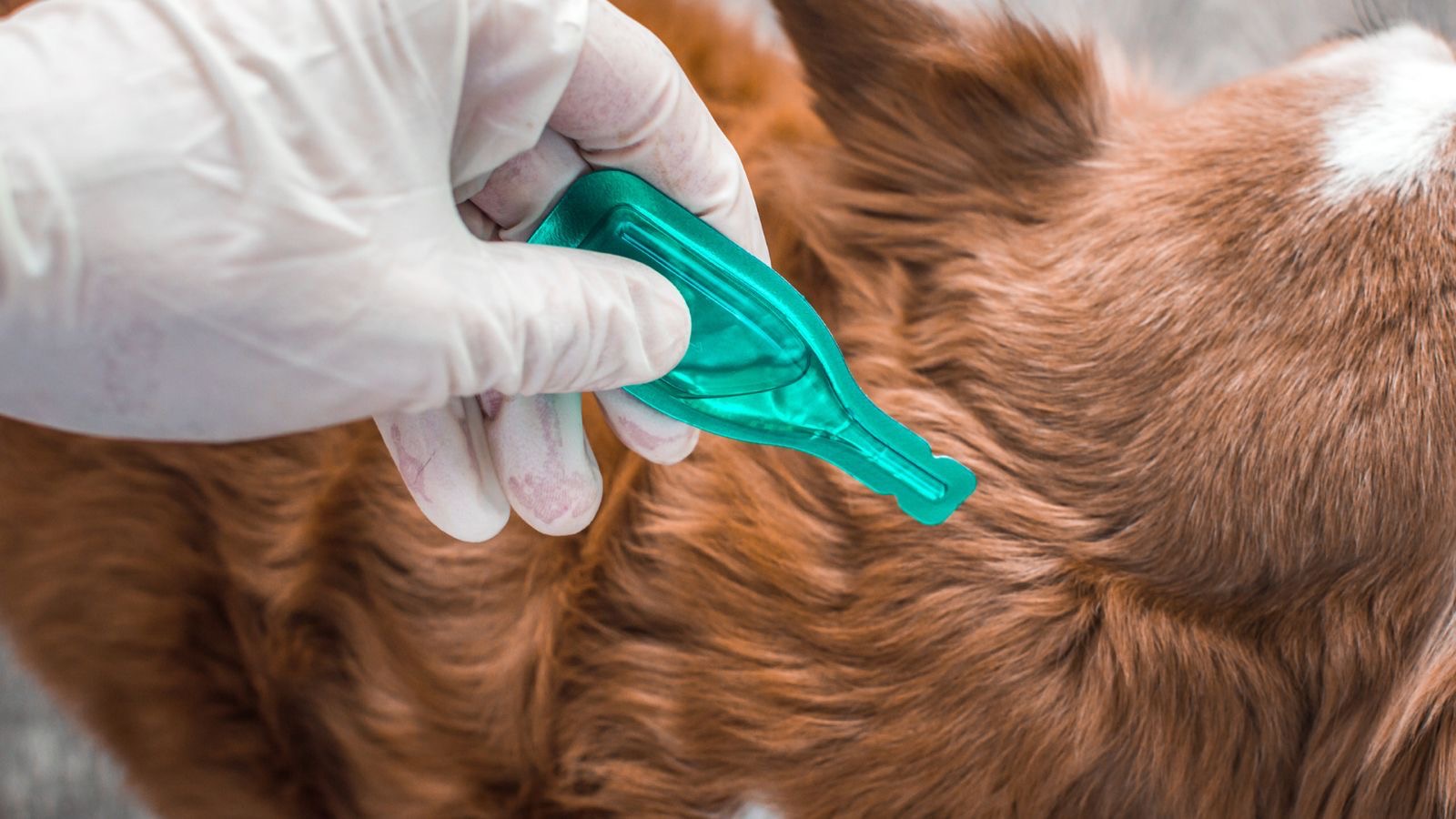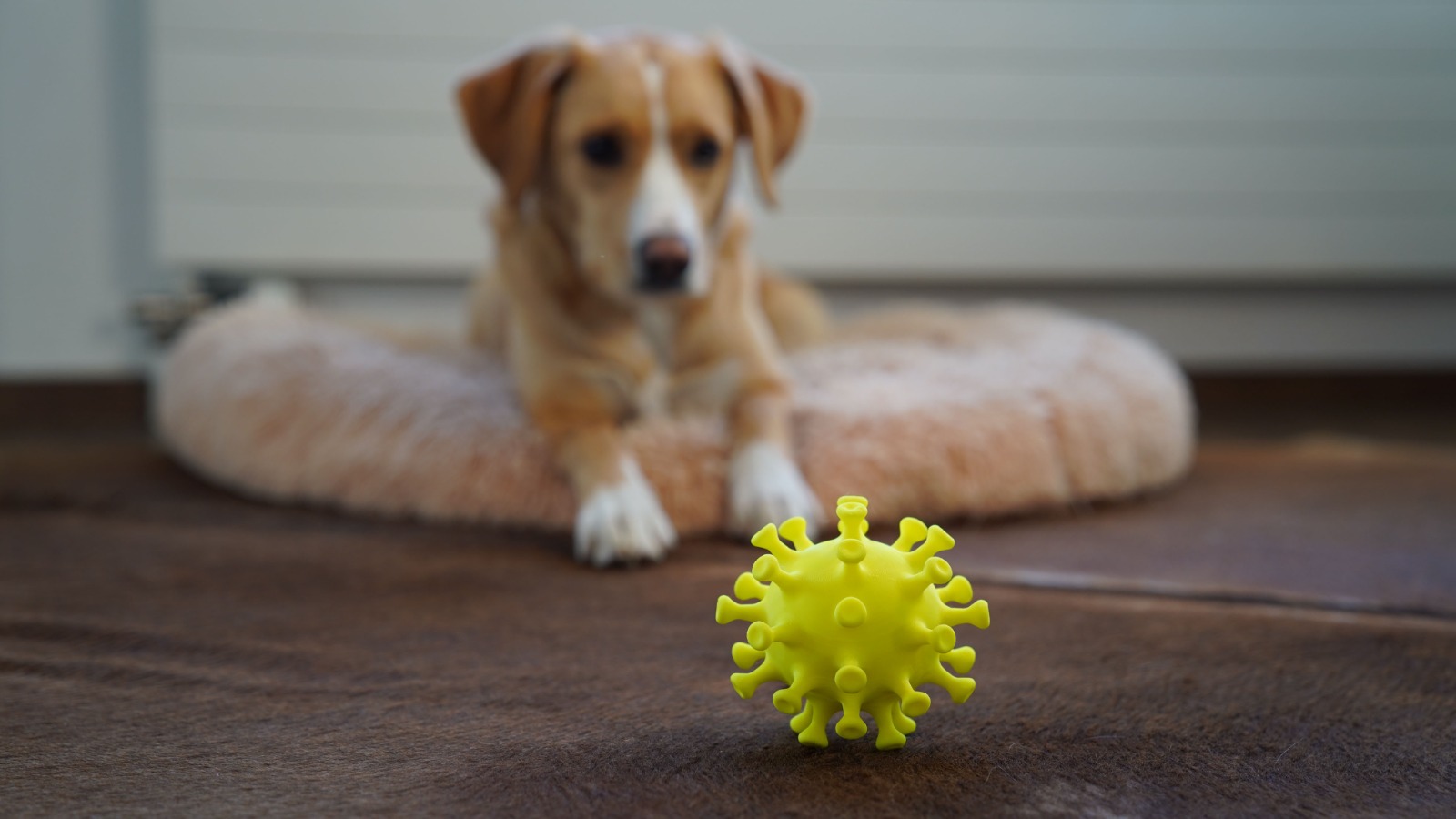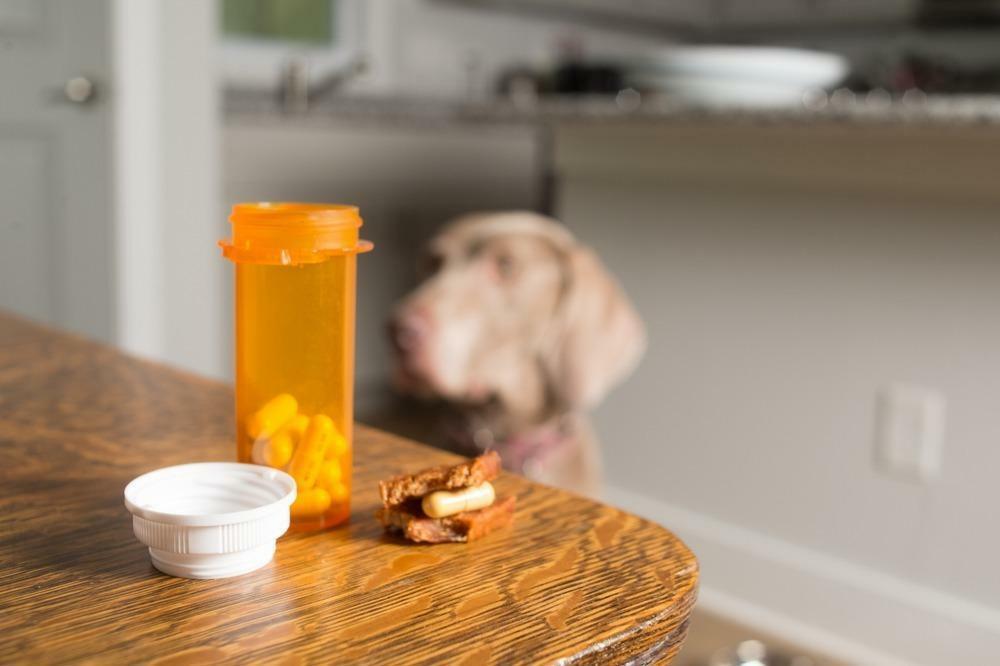-
£19.99

The Ultimate Guide on Parasites – Part 1: External Parasites
- February 16, 2024
- 11 mins 40 secs
Parasites are always a worry with our pets – let’s face it, our pets touch all sorts on the ground during their walks, sniffing sessions, and play time! It’s inevitable that they come into contact with faeces, urine, slugs, snails and so much more, giving many opportunities for parasites to be picked up, both internally and externally. Here at My Pet Nutritionist we want to help you understand more about parasites, how we can test for them, and how we can help the body rid of them. This is a bumper two part blog, providing you with all the need-to-know information regarding parasites! You can read Part 2 here!
Fleas can be picked up out on walks, or from communal dog establishments when in contact with another dog with fleas, or wildlife with fleas.
There are different types of fleas, which target different animal species, some live happily on dogs and cats too, but others can only survive on their intended species, for example hedgehog fleas can only survive on hedgehogs. Cat fleas and dog fleas are the ones most commonly seen in pet households. They can also bite their humans too!
If flea infestations are left for too long, the pet can become anaemic (particularly common in puppies), and also suffer with hair loss.
Later in this blog post, we will discuss the dangers of using isoxazolines (chewable pest treatments) and spot-on treatments for our pets. Sometimes severe infestations do require one of these products to get them under control, as well as professional house exterminators, but we recommend avoiding these products unless it is as a last resort.
Naturally, you can help prevent fleas through the use of selected essential oils (take extra caution with cats when using EOs) and neem oil on the pet, and feeding fresh garlic to dogs (though avoid feeding garlic to puppies under 6 months, and any Japanese breed as these are susceptible to allicin poisoning), as well as another herbal flea prevention supplement. There are many natural topical and internal products on the market, specifically for their target species, whether that’s cat or dog, so using these in a layered approach may give you the best chance of staying flea free!
If your pet was to get some fleas, rubbing a thick layer of shampoo onto their dry coat, and leaving for 10 minutes before rinsing out using a comb can really help control the infestation. You can also purchase electric flea-zapping combs which can have great results! In severe cases, food grade diatomaceous earth could be sprinkled onto the coat, however this is extremely drying on the skin, and can be lethal if inhaled. You will also need to focus on steam cleaning your soft furnishings, carpets etc, and clean the house regularly, making extra sure to clean any small, potentially moist nooks and crannies, and wicker items as fleas seem to love these areas!
Findings Here
Findings Here
Ticks need to be removed as soon as possible, as they can carry a range of diseases – anything from Lyme disease (which is the most common tick bourne disease in the UK, though isn’t very common I itself) to disease leading to Alfa Gal Syndrome in humans, and paralysis in the host in other countries. They really can be nasty little creatures!
To remove a tick, simply grab a tick removal tool and follow the basic instructions. They’re usually fail safe, and easy to use. If by chance, you do get the head stuck in the pet, these usually work their way out in time.
To transmit Lymes Disease, ticks have to be attached for 36-48 hours, however some species of ticks carrying more sinister diseases in countries outside the UK can transmit disease quicker, so it’s super important to check your pets twice a day, and after every walk.
You can read more about types of ticks, tick removal, and tick prevention in our blog dedicated to ticks here!
Sarcoptic mange is often referred to as Scabies. Sarcoptic mange mites tend to live on the skin’s surface, and tend to be contagious. Ivermectin is the treatment often prescribed by veterinarians to battle sarcoptic mange, however there are some potential complication to using this, which we will discuss later in this blog. Some medicated, anti-seborrheic shampoos, are often used too.
There are some natural options that may work in helping fight sarcoptic mange mites, including neem oil, turmeric, and some select essential oils such as geranium and palmarosa, which can be diluted with the neem oil.
Now, moving onto Demodectic mange. These mites are buried deeper in the skin than sarcoptic mange mites. Demodectic mange tends to happen to those with a weakened immune system, and bolstering the immune system is paramount to getting rid of them. This type of mange mite is not considered contagious, although they can transmit from mother to puppies during feeding as there is direct contact.
If you are a frequent reader of our blogs, you’ll see us talking a lot about the microbiome. The skin has it’s own microbiome, which is perfectly balanced in healthy individuals. Demodex is actually a natural part of the microbiome, however it is ‘kept in check’ by good flora and bacteria in the microbiome. When a dog is immunocompromised, the skin’s microbiome becomes out of balance, which allows for demodex to take hold, causing symptoms to start appearing.
Similarly to the conventional treatments for sarcoptic mange, the conventional treatments for demodex mange do come with some potential health concerns, discussed later in this blog post. To treat demodex mange, we really need to focus on improving the immune system. This starts with gut health! Creating a healthy gut microbiome, will help create a healthy skin microbiome, and ultimately help to rid the dog of demodectic mange mites. Feeding a mucilage herb such as slippery elm or marshmallow root, and a probiotic can greatly help heal the gut (where 80% of the immune system lays) and keep it flourishing. Our product Gut Guardian is an all-in-one supplement covering both of these!
Feeding a balanced, fresh diet also contributes to immune health, and therefore, aids in the combat against demodex. You can bathe the dog in neem based shampoos, use neem and essential oil blends on the dog’s skin (much like in the treatment of sarcoptic mange), and you can even try supplementing with quercetin as it has anti inflammatory and anti histamine properties to help ease the itching.
With both types of mange mite, it’s important to clean the house, steam clean soft furnishings, wash bedding on a hot wash, or bag and seal off soft furnishings for a week or two, so mites suffocate and die off.
Findings Here
Findings Here
These mites can be contracted from walking through long grasses and other moist vegetation, or from direct contact with another animal who has them. These mites feed in a lightly dirrent way to most other parasites – rather than sucking blood from the host, they inject a small amount of fluid into the host, which liquifies cells under the skin, which are then sucked up by the mites.
Those with an infestation of harvest mites may experience crusty skin, inflammation of the skin, itching, and sometimes secondary bacterial infection.
Veterinarians may offer a spot-on treatment for your dog, aimed at killing mites and other external parasites. Many pet owners have great success with using Thornit/Canker Powder to treat harvest mites without the risk of side effects from conventional treatments.
Findings Here
These mites are not visible to the naked eye, so for a true diagnosis, your vet will need to take a sample from the inside of the ear, and run it under a microscope, where they will be able to see mites, if they’re present. Some vets use an orthoscope, but results may be better under a microscope.
Ear mites are highly contagious, so can easily be passed on from other pets who have them.
Conventional treatments of ear mites are usually prescribed by the vet, but these can come with the risk of side affects, which we will discuss later in this blog post. If you choose to use conventional treatments, or require their use as a last resort, it is important to choose one designed to target ear mites, as not all do. Another option your veterinarian may offer, is a topical ear cream or drops which has to be used daily until the mites have been cleared.
Immune health is one step in helping rid the body of ear mites – My Pet Nutritionist Gut Guardian can help with this! When looking at natural remedies to support the body in shifting the ear mites, owners may consider mineral or olive oil ear drops, which ultimately suffocate the mites. Garlic infused oil may also be an option, as garlic is a fantastic anti-parasitic. A light dusting of Thornit/Canker Powder on the inside of the ear flap can also be beneficial. Some Essential Oils may be used when mixed in with one of the aforementioned oils, but be very careful using these around cats as cats can be particularly sensitive to poisoning from Essential Oils. Catnip Essential Oil is a natural anti-parasitic, and can be great to control ear mites.
Findings Here
Findings Here
Spot-on treatments absorb through the skin and spread throughout the body. They comprise of harsh neurotoxins, suspended in harsh chemicals to allow for easy absorption. Unfortunately, these chemicals often cause chemical burns around the area of application. The instructions state to wear gloves when applying the treatments to your pet’s skin, and to wash your hands immediately if contact is made – so why are they ok to be put on your pet’s unprotected skin every month?
As mentioned, the active ingredients in these products are harsh neurotoxins, designed to attack the nervous system of the pests. This does, however, mean they can attack the dog or cat’s nervous system as well, leading to seizures – one of the most seen side affects of these products! Other neurological changes owners may see in their pets following the use of spot-on treatments include:
Non-neurological side affects include:
With these products, especially those containing Ivermectin and similar active ingredients, we need to also consider the breed of dog using it. You may have herd the anecdote ‘white feet, don’t treat’ – this is aimed at owners of herding breeds specifically, as most individuals of this category have white feet. These breeds commonly have a mutated gene – the MDR-1 gene. The MDR-1 (Multi Drug Resistance) gene is a gene which protects the brain from some drugs. Those with the MDR-1 mutation sadly lack this protection, and are even more at risk of adverse reactions to topical and chewable pest treatments.
Side affects of these products include:
These products are of particular concern to those with a history of neurological disorders, but can affect any individual, after any dose, despite a history of no side affects following prior doses of the treatment – much like playing Russian Roulette. Official current figures of reported adverse reactions and deaths from these products for the USA alone can be found on the FDA website, however it is suspected that many adverse reactions go unreported, so the figures displayed (adverse reactions totalling around the 1.5million mark, deaths around the 41,000 mark until the start of January 2024, in the USA alone) are likely not an accurate representation of the sheer numbers of those affected in the USA, let alone worldwide!
It is also important to remember that the fleas and ticks have to latch onto your dog or cat, to ingest the poisons in the blood stream, causing them to die – meaning they don’t actually prevent!
Findings Here
Findings Here
We really hope you enjoyed reading Part 1 of the ultimate guide to parasites in our pets, and that you have taken away some pointers, and food for thought regarding your pets’ pest prevention and control regime moving forward. Head over to Part 2, all about internal parasites, which can be found here!
Team MPN x
Welcome to part 1 – External Parasites
Fleas
Fleas can be identified as tiny black insects, moving in a hopping form. They jump and crawl around your dog, using a long feeding tube to suck blood from under your dog’s skin. they are very much visible to the naked eye, and another sign of fleas being present, is the dirt they leave behind – this can be identified as black matter in patches across the skin of the dog, at the base of hair follicles.Fleas can be picked up out on walks, or from communal dog establishments when in contact with another dog with fleas, or wildlife with fleas.
There are different types of fleas, which target different animal species, some live happily on dogs and cats too, but others can only survive on their intended species, for example hedgehog fleas can only survive on hedgehogs. Cat fleas and dog fleas are the ones most commonly seen in pet households. They can also bite their humans too!
If flea infestations are left for too long, the pet can become anaemic (particularly common in puppies), and also suffer with hair loss.
Later in this blog post, we will discuss the dangers of using isoxazolines (chewable pest treatments) and spot-on treatments for our pets. Sometimes severe infestations do require one of these products to get them under control, as well as professional house exterminators, but we recommend avoiding these products unless it is as a last resort.
Naturally, you can help prevent fleas through the use of selected essential oils (take extra caution with cats when using EOs) and neem oil on the pet, and feeding fresh garlic to dogs (though avoid feeding garlic to puppies under 6 months, and any Japanese breed as these are susceptible to allicin poisoning), as well as another herbal flea prevention supplement. There are many natural topical and internal products on the market, specifically for their target species, whether that’s cat or dog, so using these in a layered approach may give you the best chance of staying flea free!
If your pet was to get some fleas, rubbing a thick layer of shampoo onto their dry coat, and leaving for 10 minutes before rinsing out using a comb can really help control the infestation. You can also purchase electric flea-zapping combs which can have great results! In severe cases, food grade diatomaceous earth could be sprinkled onto the coat, however this is extremely drying on the skin, and can be lethal if inhaled. You will also need to focus on steam cleaning your soft furnishings, carpets etc, and clean the house regularly, making extra sure to clean any small, potentially moist nooks and crannies, and wicker items as fleas seem to love these areas!
Findings Here
Findings Here
Ticks
Ticks get a really bad reputation – and for good reason, especially in some countries outside of the UK. Ticks can be identified as having a bulbous body, with very small head, and 8 legs, protruding from the head area. When they’re attached to your pet’s skin, you will be able to see the large rounded body (the larger the body, the more the tick has fed), with some legs seen very close to the skin.Ticks need to be removed as soon as possible, as they can carry a range of diseases – anything from Lyme disease (which is the most common tick bourne disease in the UK, though isn’t very common I itself) to disease leading to Alfa Gal Syndrome in humans, and paralysis in the host in other countries. They really can be nasty little creatures!
To remove a tick, simply grab a tick removal tool and follow the basic instructions. They’re usually fail safe, and easy to use. If by chance, you do get the head stuck in the pet, these usually work their way out in time.
To transmit Lymes Disease, ticks have to be attached for 36-48 hours, however some species of ticks carrying more sinister diseases in countries outside the UK can transmit disease quicker, so it’s super important to check your pets twice a day, and after every walk.
You can read more about types of ticks, tick removal, and tick prevention in our blog dedicated to ticks here!
Mites
Mites come in various forms. The most common ones we see, are Mange (of which there are two types), harvest mites, and ear mites. Let’s take a look at some of these.Mange
Mange presents as large areas of hair loss and scabbing. In severe cases, dogs can become completely bald. To test for mange, your veterinarian will take a skin scrape – a sample of the skin’s microbiome, which is analysed under a microscope for mite activity. Each type of mite is a different shape, so the type of mite can easily be diagnosed.Sarcoptic mange is often referred to as Scabies. Sarcoptic mange mites tend to live on the skin’s surface, and tend to be contagious. Ivermectin is the treatment often prescribed by veterinarians to battle sarcoptic mange, however there are some potential complication to using this, which we will discuss later in this blog. Some medicated, anti-seborrheic shampoos, are often used too.
There are some natural options that may work in helping fight sarcoptic mange mites, including neem oil, turmeric, and some select essential oils such as geranium and palmarosa, which can be diluted with the neem oil.
Now, moving onto Demodectic mange. These mites are buried deeper in the skin than sarcoptic mange mites. Demodectic mange tends to happen to those with a weakened immune system, and bolstering the immune system is paramount to getting rid of them. This type of mange mite is not considered contagious, although they can transmit from mother to puppies during feeding as there is direct contact.
If you are a frequent reader of our blogs, you’ll see us talking a lot about the microbiome. The skin has it’s own microbiome, which is perfectly balanced in healthy individuals. Demodex is actually a natural part of the microbiome, however it is ‘kept in check’ by good flora and bacteria in the microbiome. When a dog is immunocompromised, the skin’s microbiome becomes out of balance, which allows for demodex to take hold, causing symptoms to start appearing.
Similarly to the conventional treatments for sarcoptic mange, the conventional treatments for demodex mange do come with some potential health concerns, discussed later in this blog post. To treat demodex mange, we really need to focus on improving the immune system. This starts with gut health! Creating a healthy gut microbiome, will help create a healthy skin microbiome, and ultimately help to rid the dog of demodectic mange mites. Feeding a mucilage herb such as slippery elm or marshmallow root, and a probiotic can greatly help heal the gut (where 80% of the immune system lays) and keep it flourishing. Our product Gut Guardian is an all-in-one supplement covering both of these!
Feeding a balanced, fresh diet also contributes to immune health, and therefore, aids in the combat against demodex. You can bathe the dog in neem based shampoos, use neem and essential oil blends on the dog’s skin (much like in the treatment of sarcoptic mange), and you can even try supplementing with quercetin as it has anti inflammatory and anti histamine properties to help ease the itching.
With both types of mange mite, it’s important to clean the house, steam clean soft furnishings, wash bedding on a hot wash, or bag and seal off soft furnishings for a week or two, so mites suffocate and die off.
Findings Here
Findings Here
Harvest mites
Harvest mites tend to be more seasonal than other mites, mainly being picked up in warmer weather, often between July and October. These mites are visible to the naked eye, but are extremely small, and much easier to identify under a microscope, following a sample being removed from the skin. they’re bright orange in colour, and usually found in the paws and between the toes, as well as the undercarriage, and ears.These mites can be contracted from walking through long grasses and other moist vegetation, or from direct contact with another animal who has them. These mites feed in a lightly dirrent way to most other parasites – rather than sucking blood from the host, they inject a small amount of fluid into the host, which liquifies cells under the skin, which are then sucked up by the mites.
Those with an infestation of harvest mites may experience crusty skin, inflammation of the skin, itching, and sometimes secondary bacterial infection.
Veterinarians may offer a spot-on treatment for your dog, aimed at killing mites and other external parasites. Many pet owners have great success with using Thornit/Canker Powder to treat harvest mites without the risk of side effects from conventional treatments.
Findings Here
Ear mites
Another common mite we come across regularly here at My Pet Nutritionist is the ear mite. As per it’s name, these affect the ears. Symptoms are very similar to those suffering from ear infections and yeast. Head tilting, itching the ears, shaking the head and dark waxy substances in the ear are all common symptoms of those suffering with any of these ear conditions. These are commonly seen in both dogs and cats, and usually bury deep inside the ear canal, however they can be found on the skin around the ear area too.These mites are not visible to the naked eye, so for a true diagnosis, your vet will need to take a sample from the inside of the ear, and run it under a microscope, where they will be able to see mites, if they’re present. Some vets use an orthoscope, but results may be better under a microscope.
Ear mites are highly contagious, so can easily be passed on from other pets who have them.
Conventional treatments of ear mites are usually prescribed by the vet, but these can come with the risk of side affects, which we will discuss later in this blog post. If you choose to use conventional treatments, or require their use as a last resort, it is important to choose one designed to target ear mites, as not all do. Another option your veterinarian may offer, is a topical ear cream or drops which has to be used daily until the mites have been cleared.
Immune health is one step in helping rid the body of ear mites – My Pet Nutritionist Gut Guardian can help with this! When looking at natural remedies to support the body in shifting the ear mites, owners may consider mineral or olive oil ear drops, which ultimately suffocate the mites. Garlic infused oil may also be an option, as garlic is a fantastic anti-parasitic. A light dusting of Thornit/Canker Powder on the inside of the ear flap can also be beneficial. Some Essential Oils may be used when mixed in with one of the aforementioned oils, but be very careful using these around cats as cats can be particularly sensitive to poisoning from Essential Oils. Catnip Essential Oil is a natural anti-parasitic, and can be great to control ear mites.
Findings Here
Findings Here
The Worry About Conventional Treatments
Conventional flea treatments are commonly seen as ‘routine prevention’ products, and are widely used by pet owners all over the world. While they can be effective at controlling current infestations, they sadly do not prevent the parasites from being contracted, and they come with some worrying side effects, many having official FDA warnings against them. Some examples of the products we will discuss are even banned for use in Europe by the European Medicines Agency (EMA) due to the severity of their adverse effects! Read on to find out more about the main types of products available and widely prescribed as ‘preventatives’ by veterinary professionals.Spot-On Treatments (Topicals)
These treatments have been used for decades, on our pet cats and dogs – perhaps less commonly now many veterinary practices favour the newer chewable products, which we talk about next. These treatments can be effective against current flea and tick infestations, but do not prevent, as the pests still have to latch onto the skin of the dog or cat and ingest the poisons in the bloodstream, before they die.Spot-on treatments absorb through the skin and spread throughout the body. They comprise of harsh neurotoxins, suspended in harsh chemicals to allow for easy absorption. Unfortunately, these chemicals often cause chemical burns around the area of application. The instructions state to wear gloves when applying the treatments to your pet’s skin, and to wash your hands immediately if contact is made – so why are they ok to be put on your pet’s unprotected skin every month?
As mentioned, the active ingredients in these products are harsh neurotoxins, designed to attack the nervous system of the pests. This does, however, mean they can attack the dog or cat’s nervous system as well, leading to seizures – one of the most seen side affects of these products! Other neurological changes owners may see in their pets following the use of spot-on treatments include:
- Aggression/changes in behaviour
- Disorientation
- Ataxia
- Touch sensitivity
- Higher vocalisation
Non-neurological side affects include:
- Urinary or faecal incontinence
- Dermatitis and itching
- Vomiting
- Diarrhoea
- Dry eye
- Kidney or liver failure
- Excessive drooling
- Reduced appetite
- Death
With these products, especially those containing Ivermectin and similar active ingredients, we need to also consider the breed of dog using it. You may have herd the anecdote ‘white feet, don’t treat’ – this is aimed at owners of herding breeds specifically, as most individuals of this category have white feet. These breeds commonly have a mutated gene – the MDR-1 gene. The MDR-1 (Multi Drug Resistance) gene is a gene which protects the brain from some drugs. Those with the MDR-1 mutation sadly lack this protection, and are even more at risk of adverse reactions to topical and chewable pest treatments.
Isoxazolines (Chewables)
These products are newer to the market than the traditional topical/spot on treatments we just discusses, however they have made quite an impact in the pet community, but sadly not in a wholly positive light. The number of severe adverse reactions, and even deaths, as a result of using these products is ever growing. The FDA now have warnings on the packets of all isoxazoline products to warn owners of potential severe adverse effects.Side affects of these products include:
- Seizures
- Ataxia
- Vomiting
- Diarrhoea
- Polydipsia
- Muscle tremors
- Haemolysis and excessive bleeding
- Kidney and Liver Failure
- Death
These products are of particular concern to those with a history of neurological disorders, but can affect any individual, after any dose, despite a history of no side affects following prior doses of the treatment – much like playing Russian Roulette. Official current figures of reported adverse reactions and deaths from these products for the USA alone can be found on the FDA website, however it is suspected that many adverse reactions go unreported, so the figures displayed (adverse reactions totalling around the 1.5million mark, deaths around the 41,000 mark until the start of January 2024, in the USA alone) are likely not an accurate representation of the sheer numbers of those affected in the USA, let alone worldwide!
It is also important to remember that the fleas and ticks have to latch onto your dog or cat, to ingest the poisons in the blood stream, causing them to die – meaning they don’t actually prevent!
Findings Here
Findings Here
Reporting Adverse Reactions
If you suspect your pet has had an adverse reaction to any of the products mentioned, please report to the relevant governing body for your country. Some veterinarians will do this on your behalf, but if you are unsure, please do report yourself!We really hope you enjoyed reading Part 1 of the ultimate guide to parasites in our pets, and that you have taken away some pointers, and food for thought regarding your pets’ pest prevention and control regime moving forward. Head over to Part 2, all about internal parasites, which can be found here!
Team MPN x
Customer Reviews
Explore related products
Explore Related Products
Related articles

Disease ManagementGeneral HealthCats General HealthDogs & Cats
Understanding Pet Food Labels
Jun 13 2024
•
8 mins 40 secs

Disease ManagementGeneral HealthCats General HealthDogs & Cats
The Low Down on Hypoglycaemia in Pets
Jun 06 2024
•
8 mins 25 secs

Disease ManagementGeneral HealthCats General HealthDogs & Cats
What is Pica, and Does Your Pet Have It?
May 23 2024
•
7 mins 15 secs

Disease ManagementGeneral HealthCats General HealthDogs & Cats
How to Avoid Environmental Hazardous Exposure in Pets – Part 2
Apr 25 2024
•
16 mins

Disease ManagementGeneral HealthCats General HealthDogs & Cats
How To Avoid Environmental Hazardous Exposure in Pets – Part 1
Apr 19 2024
•
9 mins 40 secs

Disease ManagementGeneral HealthCats General HealthDogs & Cats
The Ultimate Guide on Parasites: Part 2 – Internal Parasites
Feb 17 2024
•
16 mins

Disease ManagementGeneral HealthCats General HealthDogs & Cats
The Ultimate Guide on Parasites – Part 1: External Parasites
Feb 16 2024
•
11 mins 40 secs

Disease ManagementGeneral HealthCats General HealthDogs & Cats
Should I Feed Vegetables to my Pet?
Aug 10 2023
•
5 mins 30 secs

Disease ManagementGeneral HealthCats General HealthDogs & Cats
Help! My Pet Keeps Sneezing!
Jun 30 2023
•
5 mins 45 secs

Disease ManagementGeneral HealthCats General HealthDogs & Cats
5 Cornerstones of Immunity for your Pet
Jun 15 2023
•
6 mins

Disease ManagementGeneral HealthCats General HealthDogs & Cats
The Importance of Vitamins and Minerals for Thyroid Health
May 05 2023
•
9 mins

Disease ManagementGeneral HealthCats General HealthDogs & Cats
How To Choose Safe and Sustainable Pet Products
Sep 26 2022
•
3 mins 30 secs

Disease ManagementGeneral HealthCats General HealthDogs & Cats
5 Easy Cleaning Solutions For Pet Owners
Sep 26 2022
•
4 mins

Disease ManagementGeneral HealthCats General HealthDogs & Cats
6 Things All Pet Owners Should Have In Their Cupboards
Sep 12 2022
•
5 mins 40 secs

Disease ManagementGeneral HealthCats General HealthDogs & Cats
How Polluted Are Our Pets?
Aug 30 2022
•
3 mins 30 secs

Disease ManagementGeneral HealthCats General HealthDogs & Cats
How To Be A Better Pet Owner
Aug 15 2022
•
5 mins 30 mins

Disease ManagementGeneral HealthCats General HealthDogs & Cats
Supporting Wound Healing in Dogs
Jul 04 2022
•
4 mins 58 secs

Disease ManagementGeneral HealthCats General HealthDogs & Cats
How Do Pain Medications Work In Pets?
Jun 08 2022
•
5 mins 54 secs

Disease ManagementGeneral HealthCats General HealthDogs & Cats
Do We Need to Boost Our Pet’s Immune System?
Feb 15 2022
•
4 mins 42 secs

Disease ManagementGeneral HealthCats General HealthDogs & Cats
The Importance of Iron in Pet Health
Nov 23 2021
•
5 mins 10 secs

Disease ManagementGeneral HealthCats General HealthDogs & Cats
Should I Feed My Pet a Vegan Diet?
Nov 09 2021
•
5 mins 6 secs

Disease ManagementGeneral HealthCats General HealthDogs & Cats
Prebiotics Vs. Probiotics
Nov 01 2021
•
4 mins 17 secs

Disease ManagementGeneral HealthCats General HealthDogs & Cats
Are We Really That Good At Doing It Ourselves?
Sep 09 2021
•
10 min read

Disease ManagementGeneral HealthCats General HealthDogs & Cats
The Importance of Water
Jun 14 2021
•
8 min read

Disease ManagementGeneral HealthCats General HealthDogs & Cats
Parasites and What You Really Need to Know
May 17 2021
•
9 min read

Disease ManagementGeneral HealthCats General HealthDogs & Cats
How Nutrition Affects Your Pet’s Genes
Apr 19 2021
•
15 min read

Disease ManagementGeneral HealthCats General HealthDogs & Cats
Your Pet’s Immune System
Mar 15 2021
•
4 min read

Disease ManagementGeneral HealthCats General HealthDogs & Cats
Constipation in Cats and Dogs!
Feb 22 2021
•
8 min read

Disease ManagementGeneral HealthCats General HealthDogs & Cats
What is the best kind of pet food?
Jan 14 2021
•
11 min read

Disease ManagementGeneral HealthCats General HealthDogs & Cats
Is Your Toxic Home Affecting Your Pet
Dec 28 2020
•
8 min read

Disease ManagementGeneral HealthCats General HealthDogs & Cats
Why is Magnesium So Important to Your Pet
Oct 02 2020
•
10 min read

Disease ManagementGeneral HealthCats General HealthDogs & Cats
Why Dry Food is Not Good for your Pets
May 19 2020
•
5 min read

Disease ManagementGeneral HealthCats General HealthDogs & Cats
Natural Flea and Worming Treatments
May 05 2020
•
7 min read

Disease ManagementGeneral HealthCats General HealthDogs & Cats
Everything you Need to Know About Vaccinations
Apr 22 2020
•
7 min read

Disease ManagementGeneral HealthCats General HealthDogs & Cats
Itchy cats and dogs naturally!
Jan 23 2020
•
7 min read
✕






